Affiliate marketing is one of the most popular ways to make a sizeable income online.
It’s estimated that affiliate marketing accounts for 15% of all digital revenue and generated revenue of over 8 billion pounds in the UK alone.
Top affiliate marketers like Jason Stone – the man behind @millonaire_mentor on Instagram – earned over $7 million dollars by promoting relevant offers.
Brands spent over 554 million pounds on affiliate marketing in 2017.
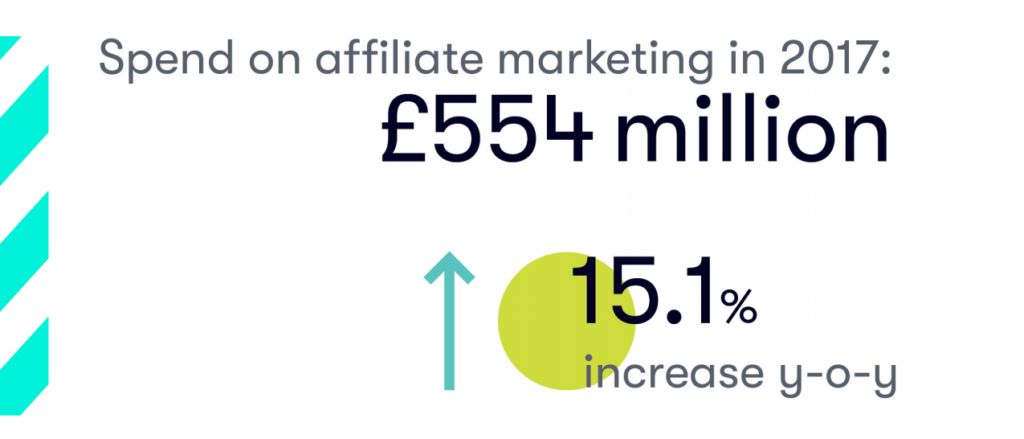
There’s a lot of money to be made but there’s also a large amount of competition. If you want to achieve exceptional results with affiliate marketing, it’s important to be in the right space and partner with the right people.
This article focuses on three essential elements of affiliate marketing:
- Choosing the right niche
- Building partnerships
- Growing authority and generating revenue
Let’s dive in.
Choosing the right affiliate niche
There are countless ways to choose an affiliate niche and you can use any criteria you want but I like to focus on just four things.
- Do I have an interest in the niche
- Are people already spending money there
- Is the market large enough to support me
- Does the market show signs of growth?
Let’s look at each one of those factors in turn.
Does the affiliate niche interest you?
Many people start affiliate marketing websites only to burn out in the long run.

That’s because, beyond the potential to make money, there’s little interest in the space. That’s like someone starting a website about music and podcast services but they’ve never listened to a podcast the last album they bought was in 2005.
They can do research and start the website strong but they’ll eventually burn out because the results don’t come fast enough. If they’re truly interested in the affiliate niche, they’ll keep going even when they’re not seeing results quickly.
Start by writing down all the things you’re interested in and prioritize them based on your preferences. The next step is to gauge the income potential.
Are people already spending money there
Even if you’re interested in something, that doesn’t mean it’ll be a good choice for affiliate marketing.
I’m interested in vintage coins but that doesn’t mean it’ll make a good affiliate niche.
Find out if people are spending money in the space by using search modifiers to search Google for your main keywords. The goal is to find multiple companies that are already operating in the space.
For example, I’d type in variations of “serverless” into Google such as “serverless software,” “serverless services” “serverless companies,” etc. If I see multiple companies or organizations spending money on ads or selling products I’d know there was potential.
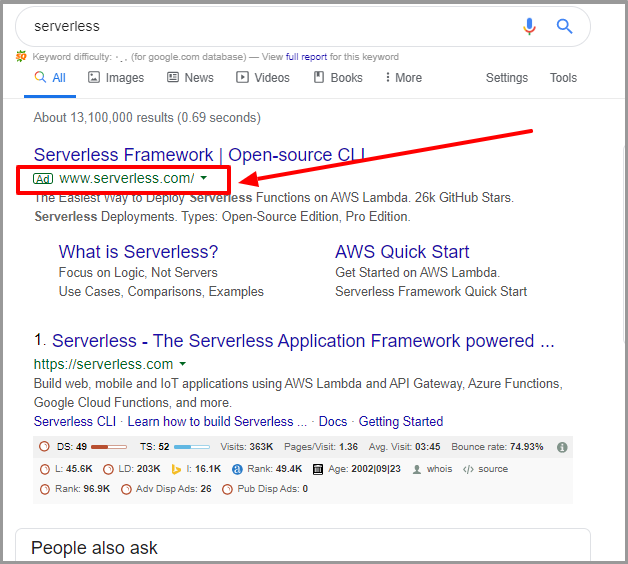
After that, go through the companies you find and look at their pricing. Are they selling low end or high-end products? Do any of the companies have visible affiliate programs?
Don’t worry if you don’t see obvious affiliate programs because you can forge your own partnerships down the line.
After determining that there are companies operating in the space, it’s important to determine whether or not the market is large enough to support you.
Is the market large enough
This is relatively simple. Use a tool like Ahrefs or Ubersuggest by Neil Patel to determine the search volume of your major key phrases then perform simple math.
For example, I’d check the search volume for serverless in Ahrefs.
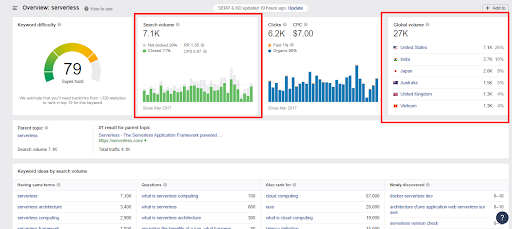
It has a search volume of 7,100 in the United States and a global volume of 27,000. If you were able to rank in position 1 for that search term then you could expect to get 30%+ of all organic search traffic. In this particular instance, that’s 9,000 visitors a month.
The average website conversion rate is 2% but a well-written review increases the likelihood that people buy because it’s a form of social proof. If an affiliate recommends the product for Serverless and got 50% of visitors to check the product and 3% convert to paying customers at $99/m, that’s 135 new customers a month.
Software companies tend to pay a 30% recurring commission which equals roughly $4,000 in revenue a month for the lifetime of the customer. If they have a low churn, you can expect to earn more than $30,000 a month after the first year which is a profitable niche.
Does the market show signs of growth
Check if the market is growing, contracting, or staying consistent. Stay away from the contracting markets, be wary of the consistent markets, and try to focus on the growing markets.
How do you find this out?
Use Google trends. Type in your major keywords and look at the performance over the last five years. Is it growing contracting, or getting larger?

Go through this process with all the interests you shortlisted and then choose the one with the most potential. If there’s a close tie between the options, consider retail – it has the most affiliate marketing investment flowing into it.
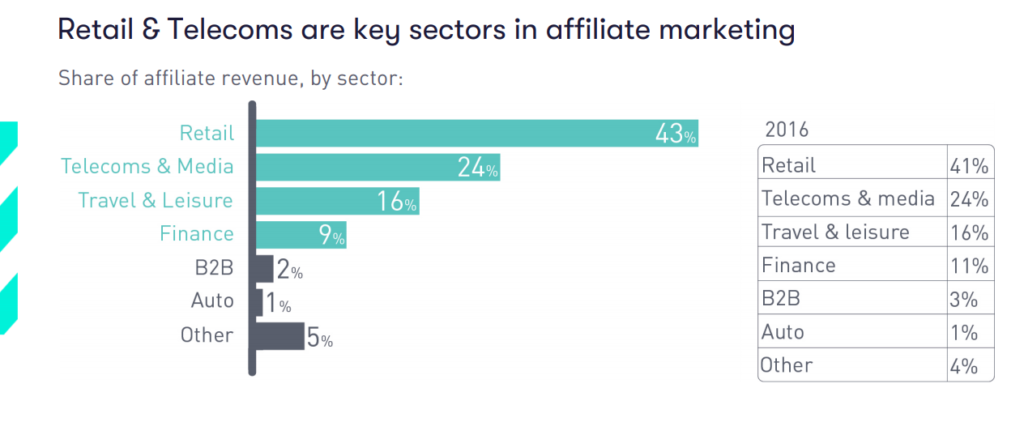
Set up your site, find affiliate programs, and move on to the next step.
Build partnerships to accelerate affiliate marketing growth
Many people don’t realize it but affiliate marketing is a team sport as opposed to a zero-sum game. People don’t have to lose for you to win.
In fact, the more people you can assist, the faster you’ll grow.
That’s exactly what some of my colleagues and I have done to rapidly grow our websites and start producing a sizeable income within months.
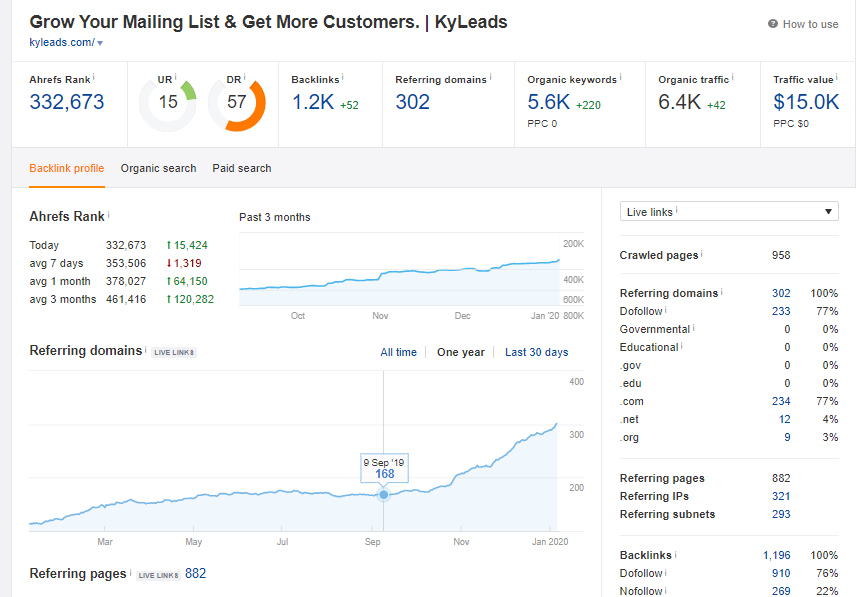
I started applying these strategies to my software company in September 2019 and within 3 months, we were able to double our links and 3x our organic traffic.
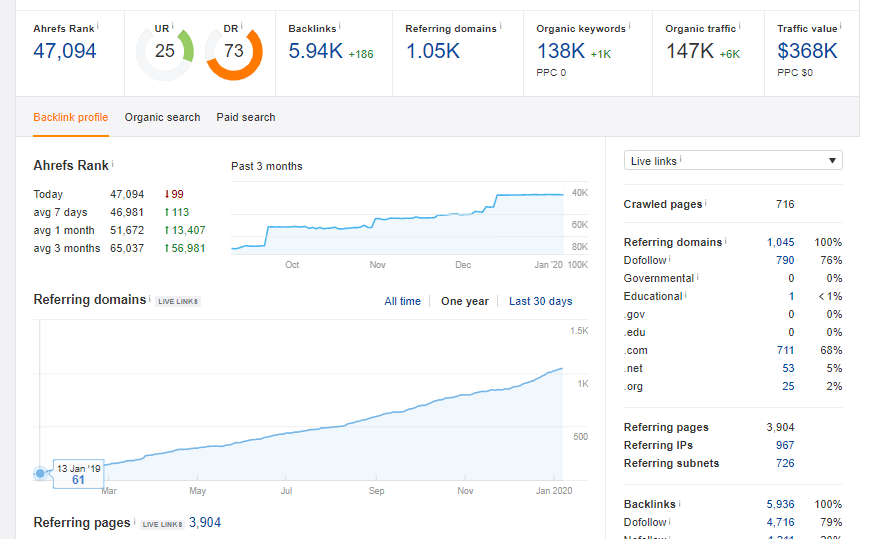
The above image is from another website that applied these strategies right from inception. Within 12 months, it gained 1,000 referring domains, almost 200k monthly search visitors, and produces just under $20,000/m.
Though I’m talking about this strategy in the context of affiliate marketing, it can be used in any niche from eCommerce where you’re shipping products by yourself to services where you’re managing multiple employees.
The core of the strategy is built on high-performance partnerships that’ll help you rank in the search engines. There are three steps to creating successful partnerships:
- Determine what an ideal partner looks like
- Figure out what to offer your partners
- Finding partners
Let’s look at each one in turn.
Determine what an ideal niche partner looks like
Each partner needs to bring something to the table that’ll make a tangible impact on your business.
That doesn’t necessarily have to be a backlink or a recommendation to their customer base. One of my partners helps us produce content while another one helps us with design work. The key is to get clear on what you’re willing to accept ahead of time.
Ask yourself the following questions:
- What kind of audience makeup should my partner have?
- What would I like to receive from my partner (a guest post placement on their website, a link placement in existing content, a continuous link building relationship)?
- Is the outcome I’m looking for possible to get by working with this partner?
- What is irrelevant to me?
- Are my partners targeting the same market segment with different products are they in a different niche?
- Can we work together directly or would it be a behind the scenes partnership?
These questions are just to get you started and clarify what you’re looking for. The next step is to decide on what you’re offering your partner.
What do you bring to the table
This is important because you’ve decided on what you want from your partner so it only makes sense that you know what you can offer in exchange.
Can you write articles for them in exchange for backlinks on other websites? Are you able to create infographics or data visualizations that people love? Do you have access to a network of websites or guest posts often which gives you an opportunity to link back to them?
Think outside the box here. You’d be surprised at what people need or are willing to partner up for. Do research about the business before you pitch them your offer.
The last step is prospecting. Your target at this point is to get at least three partners.
Prospecting and securing partnerships
I like to use LinkedIn because that’s where all the professionals are. Log in to your LinkedIn account (or make one if you don’t already have it) and use the search bar at the top of the screen.
This step requires a bit of creativity because typing in your key terms may not yield the best results. For example, serverless wouldn’t be the best search option on LinkedIn.
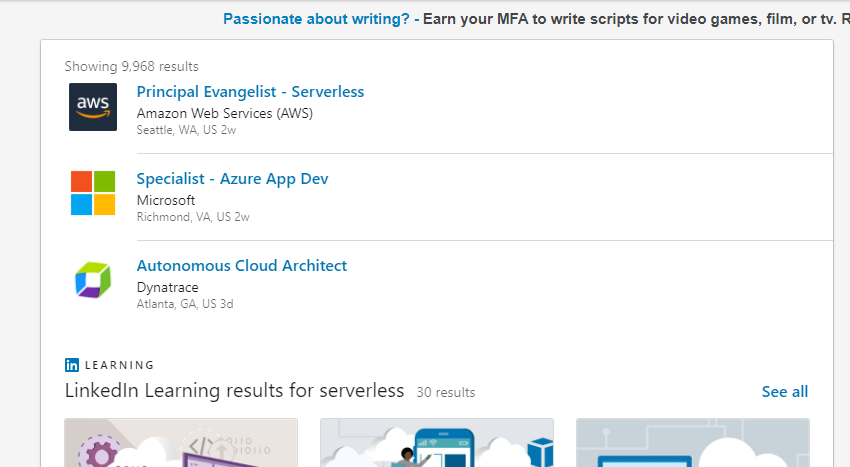
I’m getting faceless profiles that may not lead anywhere. A better search term in this situation would be something like tech blogger.
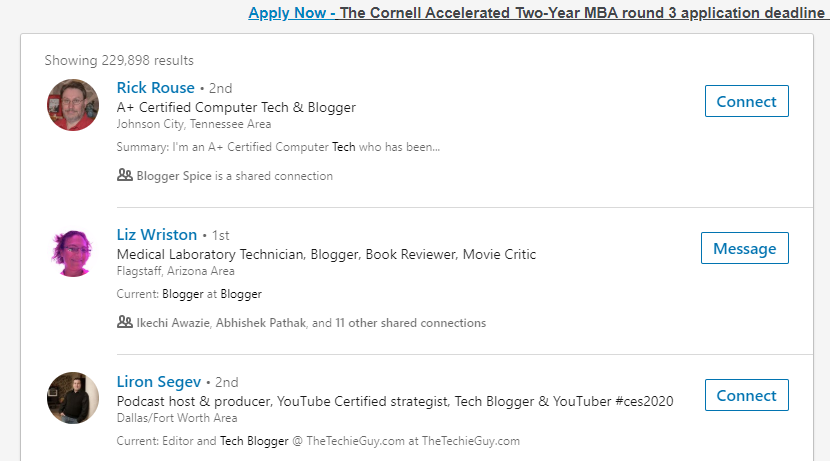
That brought back results I could actually use. Go through the same process with your space. Instead of typing in eCommerce, search for business bloggers or marketers. Once you find people that look promising, send a connection request.
After they accept, send a message asking them if they’d like to partner on link building and tell them what you have to offer in return.
Think of your outreach like this: How would you like to be approached for a partnership? Pitch your potential partners the same way. Keep the message short and clearly show what they stand to gain.
That’s it, send out roughly 20 of those and you’ll get more than enough partners. Now, it’s time for you to start delivering the goods to your partners and building links to your key pages.
Building authority rapidly
It often takes new affiliate marketers a considerable amount of time to build links and grow their organic traffic. That’s because they start off strong but fizzle out after a few weeks or months.
Partners help you grow 3 – 4 times as fast with a fraction of the effort. You just have to stick with it.
Here’s the rough math. Every time you build a link for them or deliver whatever service you’re offering, they build a link for you.
That means if you write 5 guest posts a month and link to them in each one then you’re entitled to 5 links from them as well. With 4 partners, that’s a total of 20 links for the work required to get 5 links.
If you increase that guest post-campaign to 7 articles a month and keep it up for twelve months then you’ll have built links from roughly 400 referring domains. Only 20% is from your direct effort. If you add more partners or increase your output, you can get even more results.
Let’s not get ahead of ourselves. The first thing is to find those guest post opportunities so you can deliver for yourself and your partners.
Finding guest posts placements
There are many approaches to find guest posts and I’ll share a few. I encourage you to find a few strategies of your own as well.
The first method is simple. Type in “guest posting sites” in Google. You’ll find articles that have a large collection of guest post opportunities.
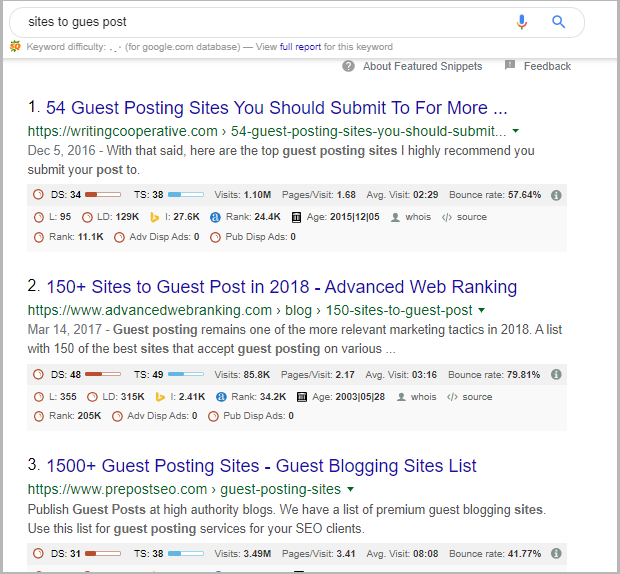
The challenge with this approach is that many of the sites you encounter are low quality, not in your niche, or require payment. As a rule, you shouldn’t pay money for a guest post-placement.
A better way is to use Google search operators to find opportunities in your niche. It’ll help you uncover websites that accept guest posts but don’t promote that fact and niche specific websites that openly accept guest posts.
Here are a few search operators:
- “[keyword]” + “write for us”
- “[keyword]” + “write for me”
- “[keyword]” + “guest post”
- “[keyword]” + “blogging guidelines”
- “[keyword]” + “become a contributor”
- “[keyword]” + “write for us”
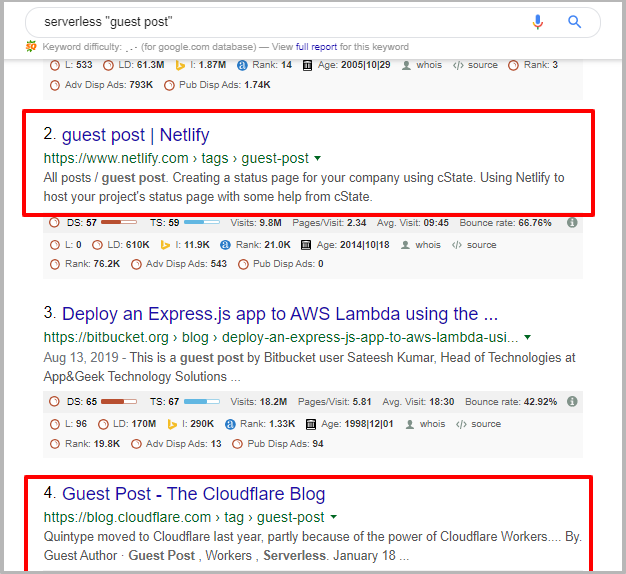
- “[keyword]” + “guest author”
- “[keyword]” + The following guest post”
- “[keyword]” + “guest blogger”
- “[keyword]” + “guest column”
- “[keyword]” + “guest article”
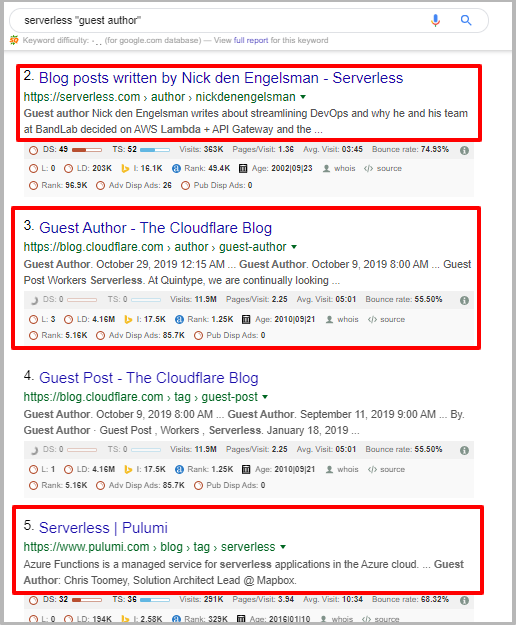
Continue this process with variations of keywords and search operators. You should be able to find hundreds of opportunities within a day. From there, start pitching websites.
How to pitch a guest post is beyond the scope of this article but here are a few things to keep in mind:
- Keep it short
- Don’t use fake compliments like “I’m a long-time reader” because you’re not fooling anyone
- Share multiple relevant topic ideas
- Share your past work
- Share one or two of your social media accounts
Once you pitch the post and it’s accepted, write the best article you can, link to one or two of your key landing pages or articles, and link to articles on the host blog as well. Your goal is to wow readers because, beyond getting a backlink, you’re also building a brand that can produce many opportunities.
To that end, consider creating marketing material for the guest posts you write. Make quotes, statistics, audio snippets, and whatever else comes to mind. Be an active part of promoting your article.
Once you’ve gotten comfortable with this entire process, you’ll be able to outsource everything from prospecting to creating the actual content. Document the most successful approaches you’ve found, create a set of standard operating procedures, then hire freelancers to handle each step of the process.
This will allow you to scale your output without sacrificing all of your time.
Other things to consider when dominating your affiliate niche
Search traffic is important but it’s, to an extent, impersonal. While you’re building your search traffic, prioritize growing your email list.
Why does it matter?
People who come to your website through search engines will consume the content they’re interested in and might also visit a few other posts. When they close the browser tab, that’s it.
They’ll likely forget about you.
If you focus on capturing contact information and using email marketing, you’ll be able to build a relationship with people over time. That relationship will allow you to present multiple affiliate offers, create and sell your own products, tap into social proof, and succeed on a larger scale.
There are three essential aspects of email marketing:
- A way to capture contact information (popups, quizzes, landing pages)
- A lead magnet that you give to people when they sign up for your mailing list
- A welcome series that sells products for you and a commitment to emailing your subscribers regularly
This is a simplified version of email marketing but it’s all you need to get started.
Conclusion
Affiliate marketing is a lucrative opportunity if you play your cards right. Many people run around in circles for a few years before they make considerable progress. This article has shown you how to quickly rise through the ranks and make exceptional progress in a short amount of time.
There are three core steps:
- Find a niche that suits you and has potential
- Build mutually beneficial partnerships
- Leverage those partnerships to rapidly build authority
It’s not complicated but people make it more difficult than it needs to be. Focus on this strategy for at least one year and you’ll see explosive results.
Share this article
Top booming affiliate niches of 2025
Discover the top booming affiliate niches of 2023 and maximize your revenue with Post Affiliate Pro! From health and veganism to gaming and luxury goods, explore the most lucrative industries to align with your brand and audience. Unleash the potential of affiliate marketing by choosing the right niche today!









